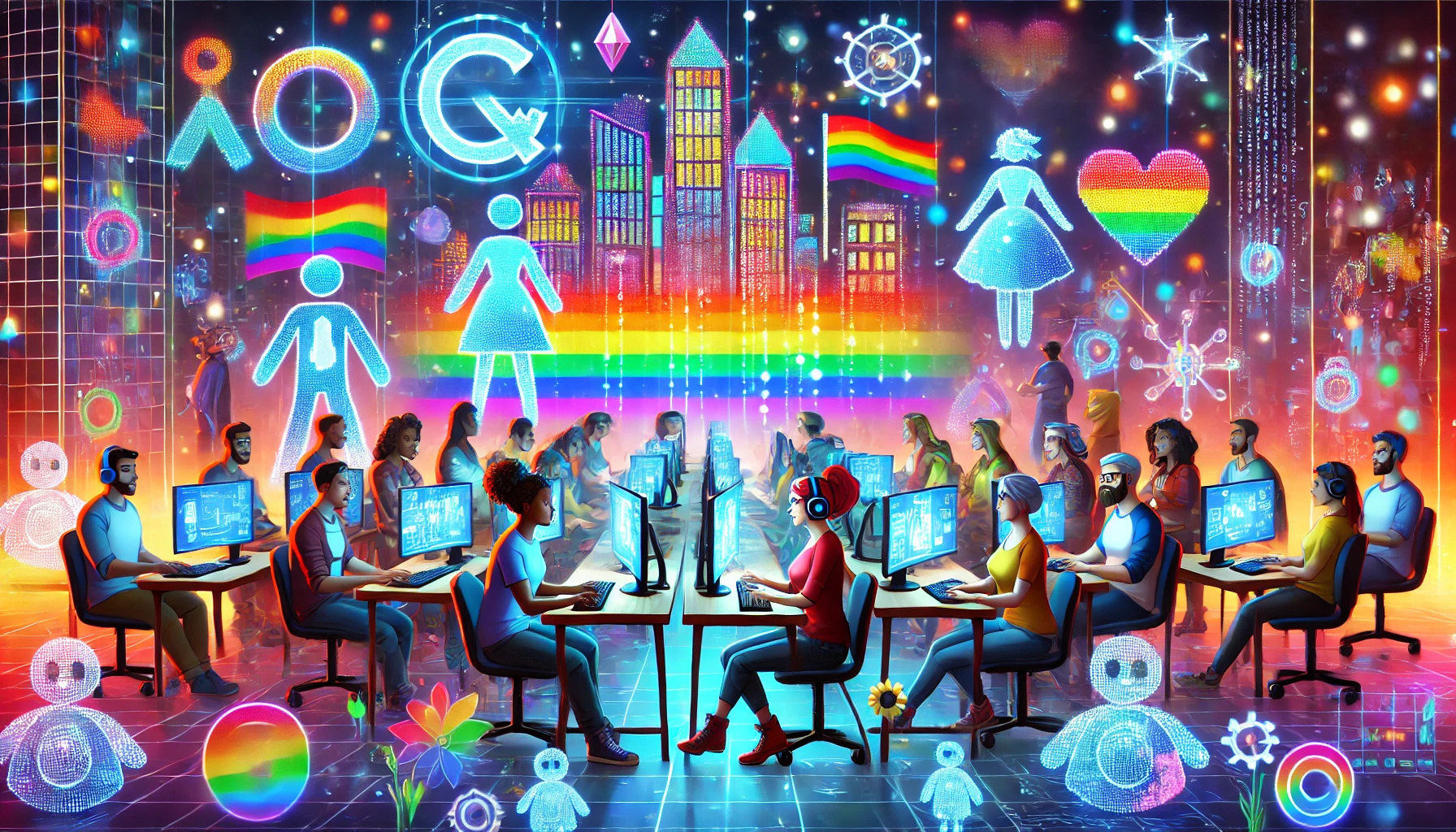
Video games are no longer only a hobby for entertainment value. They have evolved into a potent tool for influencing society's standards, shining culture, and giving many voices a stage. Long ago, though, many underprivileged groups including women, people of color, LGBTQ+ people, and those with disabilities have not been adequately represented in the gaming industry.
Game creators should produce games with more varied, truthful, and real depictions of various groups. In this post, I'll explain how game production may more effectively represent underprivileged populations and why this is crucial.
Understanding Marginalized Groups in Gaming
To understand how game development can better represent marginalized groups, it's important to first define who these groups are. Marginalized groups are those who have been historically excluded, oppressed, or misrepresented in society. This includes racial and ethnic minorities, LGBTQ+ communities, people with disabilities, and women.
People of color often face negative stereotypes or a lack of representation in slot game development, while LGBTQ+ individuals are frequently overlooked or depicted through limited, stereotypical lenses. Characters with disabilities are rarely featured, and when they are, it’s often in ways that lack depth or realism. Women in games have long been underrepresented or relegated to secondary, stereotypical roles.
For many years, these groups were either absent from games or portrayed in ways that reinforced harmful biases. However, the growth of the indie game scene and the increasing diversity of gamers have highlighted the demand for more inclusive, authentic representation. Today, players are seeking games that reflect a broader range of identities and experiences.
As the gaming industry evolves, creating more accurate and respectful portrayals of marginalized groups is not just an ethical imperative but a valuable opportunity to engage a wider, more diverse audience.
The Role of Video Games in Shaping Culture
Furthermore, video games are really important in forming society's values and cultural narratives. Games are a powerful means of narrative, not only about conquering challenges or foes. Developers of worlds, characters, and plots mirror the ideals we have as a culture. That said, we must understand that excluding or misrepresenting some groups not only damages those communities but also influences players who might not be familiar with such experiences.
One can find positive effects from video games. Games like The Last of Us Part II, for instance, have demonstrated how it is feasible to build sophisticated, nuanced characters from underprivileged groups, therefore enabling players to interact with viewpoints they might never have come across in their daily lives. Such games encourage empathy and help to break down boundaries qualities we should aim for in all game production.
Moreover, among the few mediums available that let people pretend to be someone else is gaming. Through their stories and characters, developers can thus inspire empathy and understanding among their audience. By means of immersive storytelling, players can go through the hardships and pleasures of underprivileged people, therefore creating fresh channels for interaction and shared experiences.
The Challenges in Representing Marginalized Groups
The challenges in representing marginalized groups involve navigating stereotypes, ensuring authentic voices, and addressing systemic biases that often erase or misrepresent their experiences and identities.
-
The complexity of Game Development:
-
Development of a game is a complex process, and including different characters means conquering several challenges.
Cultural and Financial Barriers:
-
Financial restraints and cultural views can make it difficult for underprivileged populations to be included in games.
Lack of Diversity in Game Development:
-
White, male developers have traditionally controlled the field, which has produced stories and characters reflecting their own experiences.
-
A homogeneous development team can help to sustain unconscious prejudices, therefore restricting the accurate portrayal of underprivileged populations.
Resistance from the Gaming Community:
-
Increased diversity and inclusivity in games challenge or make some players uncomfortable.
-
The backlash from some areas of society can deter developers from following more inclusive representation.
Impact of Insufficient Diverse Voices in Development:
-
Genuinely inclusive and diversified characters in games are challenging without different voices behind the scenes.
Best Practices for Better Representation in Game Development
Understanding the difficulties now will help us to concentrate on how we might overcome them and produce better images of underprivileged groups in games. Several recommended practices can assist in increasing diversity in game creation.
-
Incorporating Diverse Characters: Making sure the characters in a game originate from a range of origins, civilizations, and experiences is one of the first tasks. It is insufficient to only include a token figure standing in for a minority group. Characters should, instead be well-rounded, with depth, drive, and personal agency. For example, the protagonist, Madeline, in Celeste is not only a woman but also battles mental health problems. Her significantly more genuine and sympathetic character comes from this increased complexity.
-
Hiring Diverse Development Teams: Games representation begins behind the scenes rather than merely in front of the screen. People from underprivileged communities should ideally be part of developers teams. This covers authors, artists, designers, and directors who can offer their particular viewpoints and background. Teams that are diverse themselves have developed many of the most popular games featuring varied representation.
-
Consulting with Members of Marginalized Groups: Developers should speak with people from the groups they are highlighting to guarantee authenticity. Should a game include a character from the LGBTQ+ community, for example, the development team should collaborate with LGBTQ+ people to ensure the character's narrative is courteous and fairly depicts their experiences. Working with folks who have lived these events helps developers avoid mistakes and create a more real representation.
-
Designing for Accessibility: Accessibility tools should also be part of games so that people with disabilities may enjoy them. For players with mobility issues, this could include subtitles, colorblind modes, or bespoke control schemes. Including accessibility in game creation not only makes the game available to a larger audience but also conveys the idea that every player is appreciated.
-
Avoiding Harmful Stereotypes: The fact that gaming depends on negative stereotypes to depict underprivileged communities is among its most detrimental features. Developers should invest time in creating sophisticated characters who reject these preconceptions. For instance, they might show a Black character as the hero of their narrative, with their motives, aspirations, and challenges instead of as a sidekick or villain.
Having said that, already some games have effectively produced more realistic and inclusive depictions of underprivileged communities. Let's closely examine a few of them.
Games That Successfully Represent Marginalized Groups
Successful representations of underprivileged groups in games help to challenge preconceptions, provide real stories that speak to underprivileged people, and thereby empower different voices.
-
The Last of Us Part II: Strong female heroes and LGBTQ+ persons abound in this game's ensemble of characters. The main character Ellie is shown as a multi-dimensional person with personal challenges and development over the narrative. The game also pays a lot of attention to pain and healing, which gives the portrayal of its characters complexity.
-
Celeste: This indie platformer chronicles the journey of a young woman Madeline, who suffers from mental health problems ascending a mountain. The game deftly depicts mental illness, highlighting both the difficulties and the victories of living with a mental health illness. The game also employs its story to enhance understanding and self-acceptance.
-
The Sims Series: Long champions of diversity and inclusivity, The Sims Players of the game can design characters from several backgrounds, sexes, and sexual orientations. One of the most inclusive games available on the market, the series also features people with impairments and lets a spectrum of relationship dynamics.
These games provide models of what may be accomplished when creators deliberately try to authentically depict underprivileged populations. They also demonstrate how a variety of players may relate to different characters and stories, therefore demonstrating that inclusiveness benefits everyone rather than only one group.
The Future of Game Development and Marginalized Groups
The gaming business will probably keep changing to get more inclusive going forward. More games reflecting a wider spectrum of experiences will emerge as more gamers demand varied representation and as developers from underprivileged groups enter the industry.
Game development itself will evolve to incorporate diverse voices and perspectives, ensuring that the games produced are reflective of a broader range of cultures, identities, and lived experiences.
Moreover, with the growing recognition of the impact that games can have on culture and society, we may also see more initiatives aimed at training and mentoring diverse talent to enter the gaming industry.
These programs will help equip underrepresented groups with the skills and knowledge needed to pursue careers in offshore development companies, design, programming, and other key areas. Industry leaders, educators, and organizations will collaborate on creating accessible educational pathways, internships, and scholarships to ensure that talent from all backgrounds can thrive.
As the gaming industry continues to grow on a global scale, creators will have even more opportunities to explore and portray different cultures and identities. This worldwide shift not only offers an expanded canvas for creativity but also enables a more authentic representation of underprivileged populations from around the world. The rise of indie game studios and crowdfunding platforms will also allow for a broader range of voices to enter the market, pushing the boundaries of traditional game design and storytelling.
Conclusion
Fundamentally, game creation still has a long way to go in terms of faithfully depicting underprivileged communities. Still, there is a great chance for positive transformation. Demanding better representation, support of diverse artists, and ongoing advocacy for accessibility and authenticity in games can help us developers, gamers, and advocates drive the gaming business toward a more inclusive future.

0 Comments
Post Comment